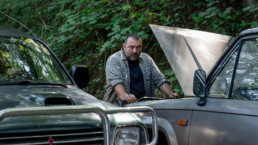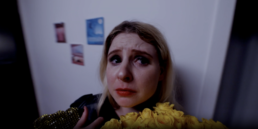On The Line
To say that On The Line, the emergency dispatch thriller from filmmaker Oliver Pearn, covers new territory would be a stretch. Predecessors with a generally similar storyline include the Danish award-winning film The Guilty (2018), the 2021 remake of the same name starring Jake Gyllenhaal, The Call (2013) starring Halle Berry, and the 2015 drama Operator (2015) starring Mischa Barton, to name a few. However, it’s worth admiring that On The Line utilizes a minimalist approach to give this micro-indie film an edge over its studio counterparts. The film builds tension with its use of only one location and one performer.
On The Line tells the story of a telephone operator residing in the northern Channel Islands in the UK. It’s the mid-1960s and telephone calls are dependent on operators successfully transferring the lines on their switchboards. For 24-year-old Agnes (Victoria Lucie), her shift at the office starts out like any other. She listens to conversations among friends and loved ones as she connects their calls without a second thought. However, Agnes is pulled back into reality after intercepting a phone call from a woman in distress who is desperate for police intervention. The woman, Martha, is in trouble and cannot share many details about her situation due to her captor being close by, so Agnes is forced to play detective and figure out how to save Martha on her own.
Shot entirely in a single room and with only one actor on screen (although the voices of the other actors are heard through the telephone), On The Line successfully builds authentic tension. The audience is with Agnes for the entirety of the film, hearing events unfold in real-time and anticipating the next move right alongside her. To this end, actor Victoria Lucie doesn’t just carry the film, she is the film.
Using a minimal, no-frills approach, filmmaker Oliver Pearn also plays into the psychology of the situation. Over the course of their scattered calls, Agnes develops a parasocial attachment to Martha and blurs the line between professional integrity and personal curiosity. This simple yet effective internal struggle adds another dimension to the character of Agnes and provides the film with an overall sense of tiptoeing around disaster.
On The Line is a microbudget indie with a bounty of potential. Never reaching above its comfort zone, the film doesn't intend to reinvent the wheel but rather add a very satisfying option to this crime drama genre.
Medusa Deluxe
The cutthroat world of competitive hairstyling turns into an up-do whodunnit in writer/director Thomas Hardiman’s murder mystery, Medusa Deluxe. Set in contemporary England, the unthinkable happens backstage at a local hairdressing competition: a stylist is scalped. Once the body is discovered, what follows is a rupture of chaos and mayhem as friends and frenemies alike begin pointing their fingers at each other, proving that in this business, obsession breeds jealousy and talent can be deadly.
Medusa Deluxe, the feature film debut from Thomas Hardiman, is a stylish thrill romp that will have you mesmerized right from the jump. Shot entirely as a one-take (and pretty convincing at that), the film effortlessly weaves in and out of green rooms and intimate conversations, building insurmountable tension with every passing minute. Obvious comparisons include Birdman, which Medusa Deluxe seems to take inspiration from in its use of backstage maze-work and seamless transitions.
Perhaps not as easily digestible for the general population as Rian Johnson’s Knives Out, Medusa Deluxe is the arthouse answer to the stereotypical whodunnit. Using shears instead of knives, Thomas Hardiman crafts an edgy, pulpy murder mystery that is propelled by a trifecta of excellence: cast, craft, and vision.
The cast of mostly unknown actors all give emotionally engaging performances. Many actors recite monologues with the intonation of seasoned thespians, which gives a sense of weight and seriousness to an otherwise surreal circumstance. The ensemble cast includes Anita-Joy Uwajeh, Clare Perksins, Darrell D’Silva, Debris Stevenson, Harriet Webb, Heider Ali, Kae Alexander, Kayla Meikle, Lilit Lesser, Luke Pasqualino, and Nicholas Karimi who are all vital players in the story’s bigger picture.
One of the biggest strengths of the film comes from the score by British electronic artist, Koreless. His signature sound of sleek, percussive electro is the perfect counterpart to the film’s fluid nature. The score consists of less “start and stop” musical moments and more continuous mood-building that fuels revelations onscreen. Feelings of uneasiness take shape through the use of off-tempo beats that sync up and then fall out of rhythm, thus painting a dreary, twisted soundscape.
Operatic in both its images and sound, Medusa Deluxe is a visionary breakthrough. Filmmaker Thomas Hardiman has created something truly unique with a voice and vision all its own. Dedicated to the hairdressers of the world, Medusa Deluxe is one fantastical trip worth taking.
Distributed by A24. Now playing on VOD and in select theaters, including the Los Feliz Theater.
Lola
Imagine Back to the Future as art-house science fiction with Christopher Nolan flare, and you’ll have some semblance of what to expect from Lola, the feature film debut from director Andrew Legge. One-of-a-kind in its execution and storytelling, Lola is a hidden gem that is just waiting to be discovered by larger audiences.
The film industry is in a tumultuous time right now with the ongoing conversations surrounding A.I. and its unknown impact. We’re seeing, firsthand, the ramifications of how technology is altering the future of film as we know it. This controversy sets the perfect backdrop in which to watch Lola, an ambitious story about how history can be made and unmade by human invention.
Lola takes place in 1941 England and centers around two sisters, Thom (Emma Appleton) and Mars (Stefanie Martini), who have built a machine that intercepts radio and TV broadcasts from the future. The machine, which they call LOLA, opens a limitless portal to the future. Turning on the device and seeing David Bowie singing “Space Oddity” is a revelation. They listen to iconic songs before they have been made, like The Kinks “You Really Got Me”, and place bets on games already knowing their outcomes. The sisters’ intention is to use LOLA for good, and they do… until things go terribly wrong.
With World War II impending, Thom and Mars use LOLA to change history by altering the course of the deadly event. Ecstatic about their contribution to history, they quickly realize that adding new variables has led to a new set of consequences. For starters, David Bowie is no longer a pop icon. In fact, they may have accidentally erased him altogether. They stopped the war and saved lives, but also existentially grapple with what they sacrificed.
Lola encourages critical thinking, much like the anecdote of the train going down the tracks toward a group of people. If you were to control the lever, would you let fate prevail and let the train strike the group, or would you alter its course by intentionally switching tracks, instead going in the direction of a single person? The film encourages audiences to examine these hypothetical questions, and therefore, I recommend watching with another person to engage in a post-screening Q&A. Transfixing performances by Stefanie Martini and Emma Appleton further add to the film’s charm. The experimental score by Irish singer-songwriter Neil Hannon is one of the most inventive and clever I’ve heard all year.
If you could control the butterfly effect, would you? Technology has the capability to enhance humanity thereby creating a perfect society, but at what cost? Lola tackles universe timeline jumping in the same fashion as Everything Everywhere All At Once, but even compared to the 7-time Academy Award-winning film, it still stands tall. A nominee for Best First Feature at the 2022 Locarno International Film Festival, Lola is a delightful film that deserves your attention.
Distributed by Dark Sky Films. Now available on VOD.
The Engine Inside
If you consider yourself a gearhead, the documentary The Engine Inside will feel like a warm embrace from the greater cycling community. However, those who aren’t passionate about the two-wheeled machine may feel a bit like an outsider looking in. Regardless, the film’s niche commercial appeal has a wider universal message that applies to everyone: a bike has the potential to solve global problems and move humanity forward. We just need to be willing to embrace it.
The Engine Inside, directed by Darcy Wittenburg, Colin Jones, and Darren McCullough, is more than just a love letter to the bicycle. It teeters on appearing like a PSA, or a long-form call to action to get audiences to ditch their cars and incorporate more bikes into their daily lives.
This nearly 200-year-old machine is the star of the film, its importance made known from the voiceover narration by a David Attenborough-sounding English gentleman. Throughout the brisk 83 minutes, we are introduced to people from all over the globe whose lives have been greatly affected by a bicycle. Through their vulnerable stories, we come to realize that a bike can be more than a tool or a toy, many consider it a source of therapy and freedom.
It’s clear that this film was made with the purest of intentions and goodwill, and not necessarily for cinematic accolades and awards. That said, at times it lingers on melodramatic moments that distract from the film’s intention of hopefulness. Slow-motion crying about past trauma and claims of feeling “discriminated against” or that “humanity treats people on bikes like punching bags” comes off heavy-handed. No doubt these emotions are valid but perhaps the effect would have been toned down if the documentary didn’t also incorporate a strong dependence on music with lyrics. The film is wall-to-wall music, which can come off as claustrophobic and forced.
The Engine Inside doesn’t necessarily tell the history of the bike, but rather the effects of the bike on people’s lives. Interesting facts are sprinkled throughout, like where the white “ghost bikes” originated from, and how bicycles and cars share the same laws. By the end of the documentary, it is the filmmakers’ goal that audiences consider this alternative way of living. After all, it is the cleanest engine around.
Passages
Passages, the new film by acclaimed American director Ira Sachs, has the potential to be one of my favorite films of the year. A love triangle of sadness set in Paris, the film explores the intricacy of modern relationships and how sticky they can become when a sexual awakening threatens to disrupt the dynamic. Making its premiere at the 2023 Sundance Film Festival, Passages is a rapture of desire and sexual fluidity.
Passages stars Franz Rogowski (Transit) as Tomas, a queer German film director who struggles with unexpected lust for a woman after the completion of shooting his passion project. The security Tomas once felt in his marriage to his partner Martin (Ben Whishaw, Women Talking), is shaken when he lays eyes on the beautiful Agathe (Adèle Exarchopoulos, Blue Is the Warmest Color) at his film’s wrap party. Naturally seductive and charismatic, Agathe persuades Tomas to follow her to the dance floor after Martin turns down Tomas’s pleas to dance, citing an early wake-up call the next day. In the middle of a crowded club, electro-disco blaring, Tomas and Agathe move in complete synchronicity. Their first encounter doesn’t quite reach a palpable sexual tension, but rather an intriguing curiosity and flirtation.
Tomas ends up spending the night with Agathe and immediately tells Martin about his sexual deviation the next morning. Martin is understanding of Tomas’s desire for exploration but somewhat dismisses the event as a one-time thing. After all, Tomas isn’t attracted to women, or so Martin thinks. The bisexual grey zone Tomas finds himself straddling becomes almost too unbearable. He can’t stop thinking about Agathe, his uncaged animalistic desire to spend time with her, sleep with her, and build a concurrent life with her becomes what he now desires. He’s fallen in love with her, and her with him, but anytime Tomas feels too removed from Martin, he also can’t help but crawl his way back into Martin's life too.

Ira Sachs’s seductive, NC-17 drama continues in a rather exhausting way for Tomas. His displays of love toward Agathe and Martin are expressed and then squandered as Tomas realizes that choosing between the two proves impossible. Things get even more complicated when Agathe reveals something that will change the course of Tomas and Martin’s life forever.
Bringing empathy to an otherwise self-absorbed character, Franz Rogowski gives one of the best performances of his career. He is a magnet on screen, visibly working through a never-ending stream of complicated emotions. Acting opposite him as his dejected lover is Ben Whishaw, whose own character's journey is fascinating. Don’t mistake his quietness for weakness, as Martin seems to be the ultimate voice of reason in the film. Adèle Exarchopoulos once again proves her star power with an incredible turn as Agathe, the strong-willed Parisian whose self-imposed blinders to Tomas’s double life is a constant, depleting struggle.
It’s no surprise that Passages is expertly crafted, from the set design to the styling and soundtrack. In the early moments of the film, when Tomas and Agathe meet for the first time, the song that accompanies this crucial moment has the lyrics, “I know you but I want to know you more” – an obvious foreshadowing of their tumultuous love affair. The film ends with a jazz piece, symbolic of chaos and disorientation.
Passages, distributed by MUBI, is an unconventional love story for modern times. From top to bottom, it’s an unforgettable watch that leaves ripples of desire and despair in its wake.
The Beasts
The thought of human extinction is a truly terrifying concept. Whether it be from ecological threats brought on by climate change, or at our own hands through over-consumption and corporate greed, those who choose a simple life are increasingly facing difficulties. As society adapts to more advanced technology and capabilities, those who refuse to adapt either get lost in the nostalgia of the past or are forced to embrace the changes.
Survival and identity are key elements in Spanish director Rodrigo Sorogoyen’s haunting eco-thriller The Beasts, a simmering piece of filmmaking that broods with tension and despair. Part true-crime drama and part social realism, The Beasts is an exceptional viewing experience that offers multi-layered commentary on gentrification and the repercussions of strongly-held beliefs.
Set in a picturesque Galician farming village commonly referred to as the “Wild West” of Spain, a middle-aged French couple, Olga and Antoine (Marina Foïs and Denis Ménochet), find themselves at odds with their contentious neighbors after moving into the community. Their new home sits in a region that, while beautiful, is fraught with economic hardship and desperation. The couple, uprooted from their previous life, decide to relocate to the village to try their hand as organic farmers. Their love for the work is unquestionably pure; Olga and Antoine rigorously stick to their harvesting schedule so they have enough produce to sell at the local farmer’s market in town. Their land is their livelihood, and the most important asset in their lives.
However, longtime residents of the village aren’t thrilled with their new neighbors’ hobby, especially when it comes between a potentially lucrative business deal. Local brothers, Xan (Luis Zahera) and Lorenzo (Diego Anido), are also farmers who’ve struggled for generations to earn a living but see their ticket out of survival mode when foreign interests offer quick cash to use the land to develop wind turbines. Olga and Antoine strongly object to selling the property, which enrages the brothers. Psychological torture ensues, causing Antoine to fear for his and his wife’s safety. This brewing fight between good-intentioned immigrants and desperate natives reaches a breaking point toward the middle of the film, building to a crescendo that is entirely gripping.
In The Beasts, Rodrigo Sorogoyen creates a dazzling display of complex gentrification dynamics through beautiful visuals and a pulsating score. The soundtrack by composer Olivier Arson creeps in and out of scenes with its organic melodies. The instruments sound as if they could have been sourced from natural elements, adding to the earthy tone that encompasses the film. Conceptually, the film feels breathy and lived in. The actors – who all give phenomenal performances – are given space and time to embody the dialogue, without any feeling of rushed or inconclusive moments.
Akin to the Icelandic eco-thriller Woman at War, The Beasts similarly hits on the struggle to preserve our natural environment. What this film does so well is portray all of the sides to the story, blurring the line between victim and perpetrator. Winner of nine Goya Awards, Spain’s equivalent of the Academy Awards, including Best Picture and Best Director, The Beasts is a revelation and a film not to be missed.
Distributed by Greenwich Entertainment. Opening at the Laemmle Royal this Friday, 8/4.
Kokomo City
Winner of the 2023 Sundance Film Festival NEXT Innovator Award and the NEXT Audience Award, Kokomo City is a fireball of energy and truth that is ready to burst into theaters. Directed, produced, edited, and shot by filmmaker D. Smith, Kokomo City proves that a documentary is only as good as its subjects, and what we have here are excellent subjects telling unapologetically raw and unforgettable stories.
Seen through a bold black-and-white filter, this tell-all highlights four Black transgender sex workers in Atlanta and New York City. Daniella Carter, Koko Da Doll, Liyah Mitchell, and Dominique Silver share their private experiences – past and present – as “entrepreneurs” who have taken an unconventional route toward self-sufficiency and independence. Unfiltered and definitely NSFW, the women get candid as they bare all to D. Smith whose understanding and empathy permeates from behind the camera.
Kokomo City humanizes the people who are often referred to as a statistic, or an “other”. We see their faces, learn their names, and are given access to their complicated world for 73 minutes. Comprised entirely of interviews which range from the logistics of "topping" and "bottoming" with clients, to familial disappointment and disownment, the film doesn’t glamorize the sex industry in the slightest but shows how the promise of fast money is enticing enough to those in desperate financial situations. It’s a sad reality that D. Smith captures with such elegance and grace through engaging and rhetorical questions.
The subject matter is dark, but there is lighthearted humor throughout the film that keeps audiences from pitying the women onscreen. Rather, we admire their bravery in the face of violence or bigotry. Despite coming from different backgrounds, the women all agree on one fact: this is survival work and it’s risky. For too long, women and those who are woman-identifying have put their lives in the hands of men, trusting them to keep us safe. For Black trans sex workers, every client is a potential threat, which highlights the horrible conditions they must continue to accept.
Aside from spotlighting a tragic existence, if Kokomo City does nothing else, hopefully, it will aid in the visibility of transgender women on screen. D. Smith has taken a conversation that has been purposefully avoided for years and made a feature film that shines a bright spotlight on these vulnerable, human experiences.
Distributed by Magnolia Pictures. Opening this Friday at Alamo Drafthouse Cinema Downtown Los Angeles.
Loud & Longing
New York City has the potential to either bring out the best in a person or break them. This city that never sleeps is a central character in Loud & Longing, a film that acts as a cinematic love letter to NYC and the brave dreamers who call it home. For as opportunity-riddled as the concrete jungle can be, many aspirational artists have been met with a reality check that threatens to crush their ambition and overall outlook on life. As this micro-indie shows, it helps to have a chosen family that understands the entrepreneurial struggle and can offer support throughout the inevitable highs and lows.
The ultra-low-budget film from directors Isabel Ellison and Ryan Guiterman tackles the darker side of chasing a dream while still weighed down by unprocessed baggage. Lucy (director Isabel Ellison) and Lucien (Sam Encarnación) are childhood friends in their early thirties who find themselves together in New York. Each a creative on the verge of a career breakthrough, Lucy, an actor, and Lucien, an artist, also share a trauma bond that emerges from the shadows when her cousin Matt (Max Carpenter) shows up in town. Matt brings with him the reminder of a shared painful history, one that includes abuse, addiction, and loss. But even in the darkest of moments, Lucy and Lucien keep their head above water with the support of their friends.
A diverse cast of queer and trans millennials creates the film's emotional heartbeat, in a similar fashion to Jonathan Larson's eclectic cast of Rent. All struggling with something, it's only through unwavering friendship that Lucy and Lucien are able to survive their worst moments. The themes of recovery and reclaiming one's identity ring true throughout the leaden script from writers Isabel Ellison and Brian Otaño.
Loud & Longing has a 2010's arthouse quality to it and presents in a similar style to the Safdie brothers' 2014 film Heaven Knows What. Stripped back of any superfluous characteristics, Loud & Longing is bare-bones but still manages to keep its edge. This aesthetic works in terms of building the world within the film but faces problems when it comes to the literal viewing of it. Dipping into questionable sound quality and mixing, the film's light and fluid nature comes to an abrupt halt when technical inconsistencies occur. Gaffes aside, Loud & Longing ultimately succeeds as an ode to the misfit and a prudent reminder that we are not an island, and should consider ourselves fortunate to have a friend in our corner.








